HR checklist for manufacturing businesses
This handy HR checklist for Kiwi manufacturers covers the entire employee lifecycle – from recruiting skilled workers, to managing health and safety requirements and much more.
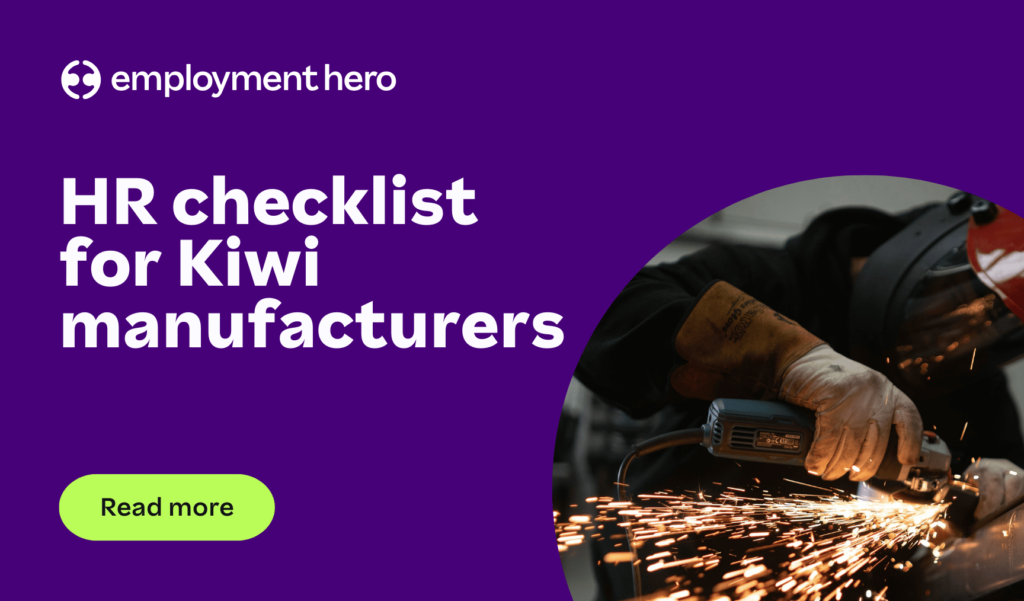
Contents
The manufacturing industry keeps thousands of Kiwis employed each year, making a significant contribution to our economy. But the people behind the magic – Kiwi manufacturing businesses – face a host of complex HR challenges along the way:
- skills shortages and high staff turnover
- seasonal demand fluctuations
- strict health and safety regulations
…and so much more.
If that sounds familiar, you’ll want to take a look at our HR checklist for Kiwi manufacturers below. From recruiting skilled workers to managing health and safety compliance, this handy checklist includes everything you need to know throughout the entire employee lifecycle.
Are manufacturing companies subject to different employment laws than other industries?

Employers in the manufacturing industry are subject to the same employment laws as other industries, including the Employment Relations Act, the Holidays Act, the Minimum Wage Act and others.
However, the nature of the work required in manufacturing calls for employers to pay special attention to the specific health and safety regulations governing these industries. The government agency WorkSafe enforces many of these regulations, and it’s governed by the Health and Safety at Work Act.
Recruitment stage
If you’ll be promoting your vacancy through conventional job boards, you’ll typically need to prepare a written advertisement:
- Outline the roles and responsibilities of the job, the type of contract (i.e. full-time, part-time, fixed-term etc), the candidate requirements and the key benefits for the candidate.
- Include any physical requirements of the role (e.g., heavy lifting, standing for long periods of time, shift work).
- If applicable, outline any union agreements or collective employment agreements relevant to the role.
- Be sure to check what certifications, qualifications or licenses (such as forklift licenses) may be required. If there are specific requirements, include them in the advert.
- Ensure the listing and screening process complies with the Human Rights Act 1993, and does not disadvantage certain people or groups based on categories including age, race or colour, sex, sexual orientation, religious beliefs and other labels.
- Ensure the role and advertised salary or wages meets New Zealand’s minimum wage requirements.
- In line with the Privacy Act 2020, you must only collect relevant personal information during the screening and shortlisting stage. You’ll find more information about employee privacy on the Employment New Zealand website.
- If required for the role, make sure that any job application forms and advertisements clearly state that applicants must disclose all criminal convictions unless covered by the Criminal Records (Clean Slate) Act 2004.
- Outline visa requirements on the job listing and verify any shortlisted candidates’ right to work.
Hero tip: With SmartMatch by Employment Hero, simply add the minimum requirements of your vacancy, including where the role is located, and automatically match with relevant job seekers. Say goodbye to countless rounds of edits to get the job listing right – just sit back and relax as the candidates come to you.
Interview process
If you’d like to interview a candidate, it’s best practice to invite them in writing.

- Be clear about when and where the interview will be held, as well as who will be on the interview panel.
- Tell candidates what to expect from your interview process to ensure they have a positive experience with your company – whether you end up working together or not.
- For in-person interviews, give helpful instructions on how to get there and make ‘reasonable accommodations’ in case any candidates have physical impairments or disabilities. You’ll find the full definition of ‘reasonable accommodations’ on the Human Rights Commission website.
- For remote interviews, let them know ahead of time what they’ll need, such as a reliable Wi-Fi connection, working device and headphones.
- During the interview, ask about their experience with any relevant safety protocols, operating heavy machinery, and following standard operating procedures (SOPs).
- Discuss physical demands of the job and ensure candidates understand the workplace conditions.
- Ensure the interview process does not disadvantage certain people or groups based on categories including age, race or colour, sex, sexual orientation, religious beliefs and other labels, as per the Human Rights Act 1993.
Reference and background checks
If you’re confident you’ve found the right candidate, you may choose to conduct references and other types of background checks depending on the requirements of the role. This isn’t a legal requirement, but it can be a useful way to verify a candidate’s suitability for a role.
- Ask for the contact details of previous employers who are able to attest to the candidate’s character, experience and professional qualities and abilities.
- You must obtain consent from candidates before conducting any reference checks, and you must only contact the references provided by the candidate.
- Verify applicants’ right to work in New Zealand (e.g., NZ citizen, resident visa, or work visa).
- In line with the Privacy Act 2020, you must only collect relevant personal information for reference and background checks.
- If the role involves operating machinery, confirm the candidate’s safety record and history of compliance with workplace procedures.
- You can check a candidate’s criminal record, but you must get their written approval to request this information from the New Zealand Police or the Ministry of Justice. A criminal record check may be particularly important if the candidate would be working with valuable goods, hazardous materials, or food production.
- Use the Criminal Records (Clean Slate) Act 2004 guidelines when assessing candidates’ criminal histories.
Hiring stage and employment agreements
Once you’ve found your candidate, it’s time to put pen to paper. Make sure you check off each of the below:
- Make a verbal offer, pending reference and background checks if applicable. Let your candidate know what the next steps are, including when and how they’ll receive the written offer and employment agreement.
- Create your written offer and employment agreement. Include things like the job title and duties, the candidates reporting manager, start date, hours of work, location and remuneration.
- Specify any workplace hazards, personal protective equipment (PPE) requirements, and hazardous substance handling.
- Include shift work, overtime conditions, night shifts, weekends, and public holidays if applicable.
- Check your agreement complies with the Employment Relations Act 2000. It should cover key details in the offer letter, as well as leave entitlements, rest and meal breaks, payment frequency, KiwiSaver, confidentiality and conflict resolution clauses and other important information.
- Send your employment agreement and written offer, ensuring your candidate has adequate time to review it before signing.
- Take care with any pre-employment health screening such as drug and alcohol testing. Any health tests requested must comply with anti-discrimination laws covered by the Human Rights Act 1993.
Payroll set up
When it comes to setting up your new starters pay schedule, there are several things to tick off your to do list.
- Check if union fees or deductions need to be processed in payroll.
- Ensure the salary or wages meets New Zealand’s minimum wage requirements.
- Ask your employee to complete an IR330 (Tax Code Declaration) form.
- For those who are auto-enrolled in Kiwisaver, make sure you give them the KiwiSaver auto-enrolment pack within seven days of their start date.
- Ask them to complete a KiwiSaver KS2 form to let you know how much they’ll be contributing to their KiwiSaver (either 3%, 4%, 6%, 8%, or 10%).
- Complete an IR346K form or submit the employee details file to MyIR.
- Ensure all the above is calculated and paid during each pay cycle, including your employer KiwiSaver contributions (employers must contribute a minimum of 3% of their employees gross salary or wages to their KiwiSaver).
- Submit regular payday filing to IRD.
- Accurately record all employee hours and wages, and retain them for six years, in line with the Holidays Act 2003 and the Employment Relations Act 2000.
- Keep copies of all IRD and KiwiSaver forms for your records.
Onboarding and induction

- Send your new starter a copy of the signed employment agreement and job description.
- Share and explain relevant workplace policies, such as your health and safety policy, your code of conduct, workplace hazards and requirements.
- Get any equipment organised they’ll need on day one.
- Provide site-specific health and safety training, including emergency procedures, PPE usage, and hazard identification.
- Ensure compliance with WorkSafe NZ regulations and the Health and Safety at Work Act 2015.
- Conduct an induction session to familiarise employees with SOPs and accident reporting procedures.
- Assign a single point of contact, such as a supervisor or senior colleague, to guide new employees through safety procedures.
- Schedule hands-on training for operating machinery, tools, and equipment.
- Review manual handling techniques to prevent workplace injuries.
Keep your new starter engaged
Checking in with your new starter regularly in their first few weeks and beyond is important to maintain engagement and overall productivity.
- Set up regular 1:1s with employees and their direct line manager. Existing Employment Hero customers can create, manage and track 1:1s all within our performance management system.
- Schedule performance reviews (usually once or twice per year).
- Ensure expectations are clear for their role, including their duties, key performance indicators (KPI) and code of conduct.
- Put wellbeing support measures in place for your employees, such as an EAP service. Employment Hero customers can access our EAP add-on for affordable, flexible employee wellbeing support.
- Work with your employee to identify career development opportunities that may suit their preferences and the needs of the business.
Ongoing obligations
- Maintain consistent payroll processes and records so that employees are always receiving the right amount of pay as per their employment agreement, tax rate, KiwiSaver contributions and leave balances.
- Make sure you’re providing adequate rest and meal breaks based on your individual or collective employment agreements, and in line with Employment Relations Act 2000.
- Conduct regular health and safety audits and ensure all staff participate in safety drills.
- Provide ongoing training in areas like machinery operation, workplace safety, and compliance.
- Keep employees informed any time there are changes to operating procedures for machinery or tools, and ensure they are adequately retrained.
- Monitor the expiry date of any employee certifications or qualifications that are required for their work, and ensure they are renewed.
- Maintain records of incidents, injuries, and near misses, and ensure all staff know what to do during a health and safety incident.
General health and safety
Every manufacturing business will use different machinery, tools and supplies, requiring specific procedures and safety measures. For that reason, it’s important you keep informed about best practice in your business. Use the following as a general guide, but please check the WorkSafe site for more detailed advice.
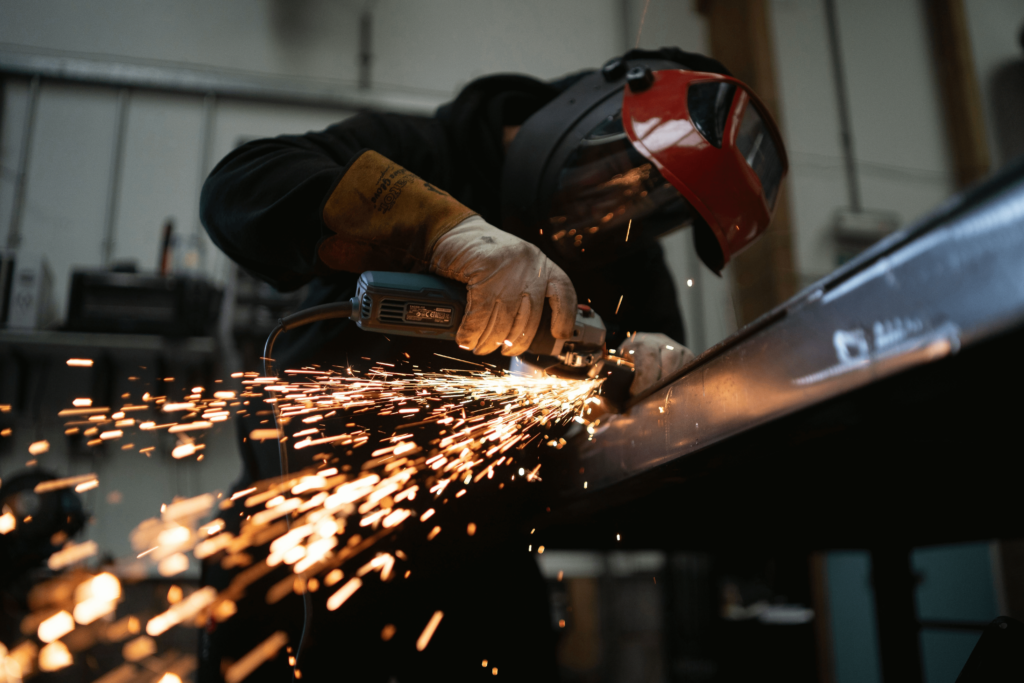
Photo credit: Josh Beech on Unsplash
- Make sure you have procedures, information, equipment and trained staff to manage emergencies.
- Ensure you provide safe, clean and hygienic facilities on site, e.g., kitchen, dining areas and bathroom facilities.
- Regularly check the safety of your workplace layout, machinery placement, lighting, ventilation, and noise, fumes and temperatures.
- Check ventilation in the building, especially if your manufacturing processes involve any form of hazardous substances or materials.
- Check the right tools or machinery are being used for each task, and that they’re being used correctly and safely.
- Ensure any guards, machinery and safety devices are secured and in good condition and operating properly.
- Ensure all materials and products are stored somewhere safe and secure
- Ensure you have a policy in place to constructively manage alcohol and other drug-related hazards.
Electrical safety
- Make sure all tools and equipment onsite are regularly examined for any faults or other technical hazards.
- Keep any loose cables and leads out of the way of anything that could damage them, for example moisture from rain or inadequate storage.
- Ensure the appropriately licensed or registered electricians carry out all electric work or maintenance needed on site.
Personal protective equipment and respiratory protection
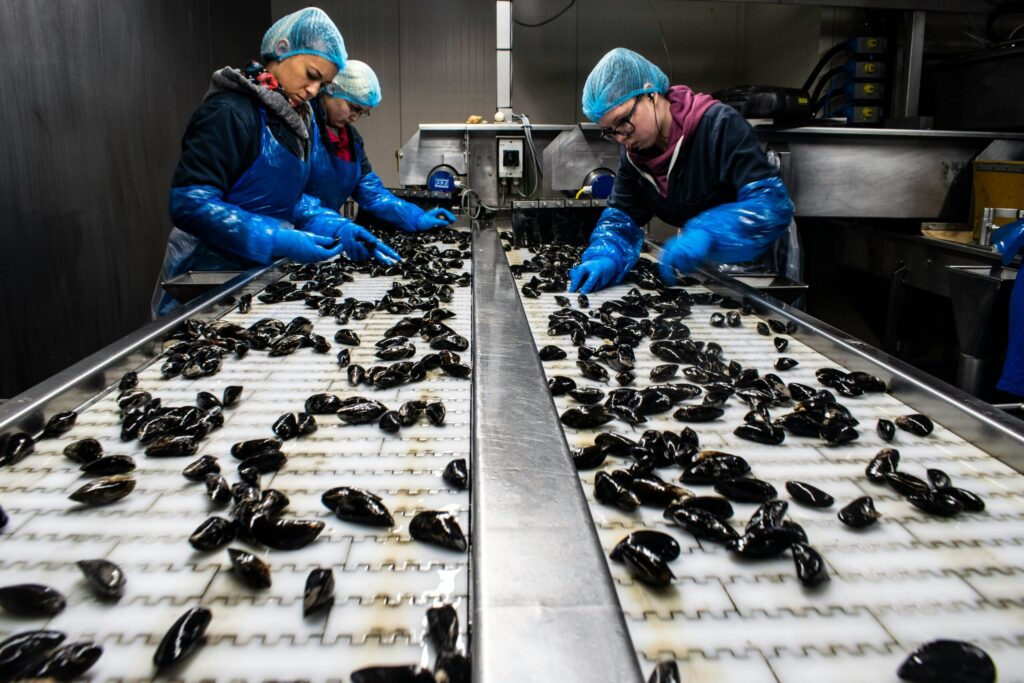
- If necessary, ensure all employees have the appropriate PPE, including protection for the head, eyes, hands, feet, and respiratory system.
- It’s a good idea to regularly check employees are wearing their PPE, and wearing it properly – according to the manufacturer’s instructions.
- Ensure any staff required to wear PPE or RPE are trained in its use, care and storage.
- Identify the appropriate Respiratory Protective Equipment (RPE) based on any hazardous substances present.
- Ensure RPE fits each worker properly and is compatible with other PPE.
- Provide health monitoring for workers exposed to solvents, fumes, dust, radiation, noise, vibration, and other hazardous substances.
Tip: it’s a good idea to outline what PPE and/or RPE will be provided, and what your expectations are for staff around PPE, in your health and safety policy.
Wellbeing in the workplace
- Ensure employees take scheduled, quality breaks in line with their employment agreements to maintain focus and energy levels.
- Keep hours reasonable and, if longer shifts are necessary, implement staggered start and finish times, extended breaks, or additional time off.
- Plan workloads strategically by avoiding critical tasks during natural energy slumps (e.g., 3 pm to 5 pm). Allow enough time for task completion to prevent undue stress.
- Set limits on overtime, consecutive night shifts, shift swapping, and on-call duties to prevent burnout.
- Rotate job tasks to limit exposure to extreme temperatures or excessive mental and physical demands.
- Take workflow disruptions (e.g., machinery breakdowns or unplanned absences) into account to maintain realistic expectations.
- Invest in an Employee Assistance Programme (EAP) to give employees the option of confidential counselling sessions.
Ready to fine-tune the factory floor? We have all the tools you need.
Clearly, manufacturing businesses face a host of challenges when it comes to complying with NZ employment laws and health and safety regulations. Fortunately, the Employment Operating System is here to help you streamline all of the above, in one central place.
From connecting with experienced machinery operators with SmartMatch, to managing employee certification renewals, shift clashes, automated payroll and more, the Employment OS does it all.
That means no more paper rosters MIA on the factory floor: just seamless digital rostering, shift management and record-keeping. Plus, the Employment OS includes an on-demand HR Advisory service, so you can get in touch whenever you need to clarify something specific.
If you’re ready to transform the way you manage employment, get in touch with one of our business specialists today.
Disclaimer: The information in this article is current as at 7 March 2025 and has been prepared by Employment Hero Pty Ltd (ABN 11 160 047 709) and its related bodies corporate (Employment Hero). The views expressed in this article are general information only, are provided in good faith to assist employers and their employees, and should not be relied on as professional advice. The Information is based on data supplied by third parties. While such data is believed to be accurate, it has not been independently verified and no warranties are given that it is complete, accurate, up to date or fit for the purpose for which it is required. Employment Hero does not accept responsibility for any inaccuracy in such data and is not liable for any loss or damages arising either directly or indirectly as a result of reliance on, use of or inability to use any information provided in this article. You should undertake your own research and to seek professional advice before making any decisions or relying on the information in this article.
Related Resources
-
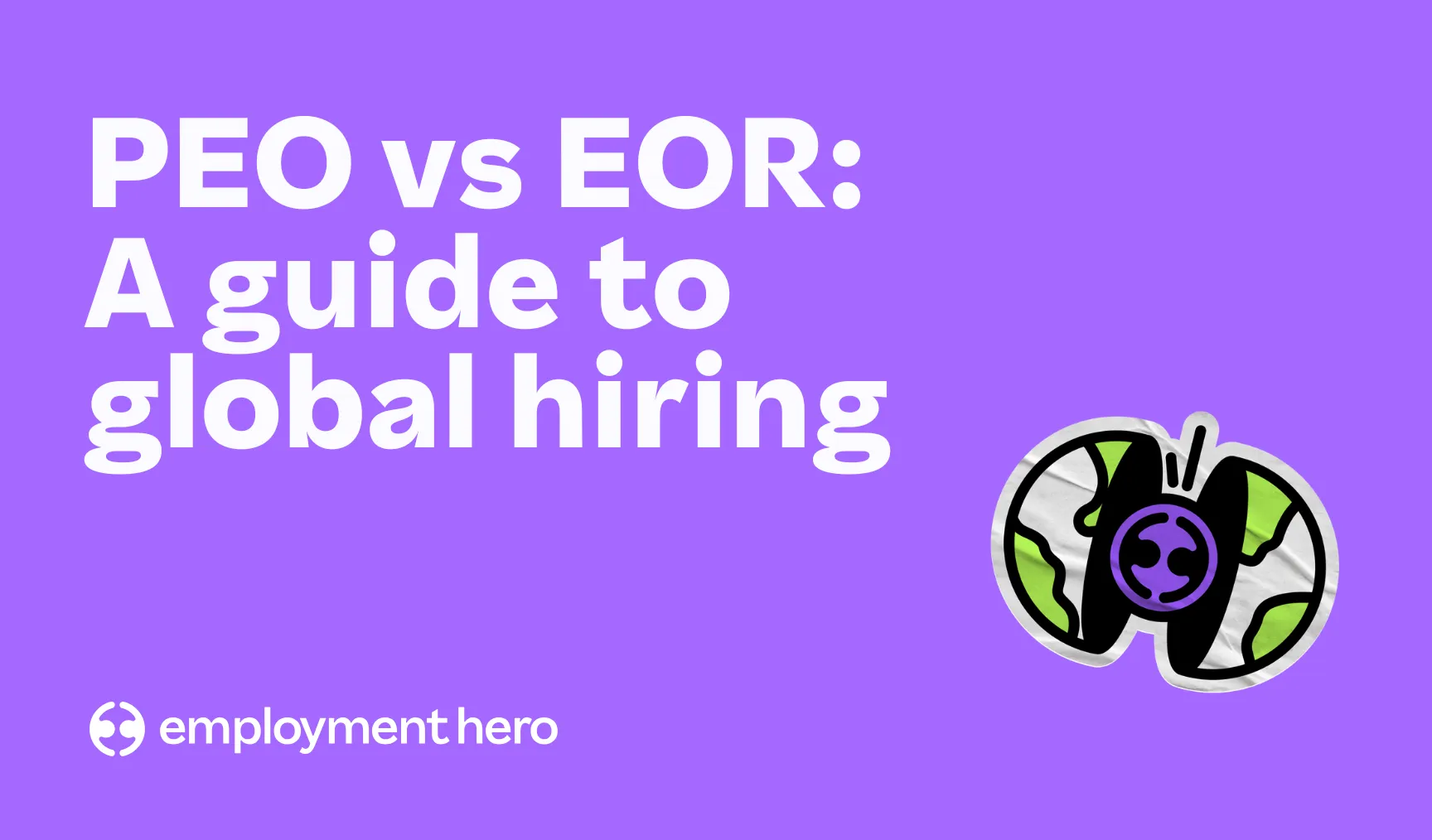 Read more: PEO vs. EOR: A guide to global hiring
Read more: PEO vs. EOR: A guide to global hiringPEO vs. EOR: A guide to global hiring
Learn the key differences between a PEO and an EOR. Discover why an EOR is the smarter, safer way to…
-
 Read more: How to build a global team without a local entity
Read more: How to build a global team without a local entityHow to build a global team without a local entity
Learn how to streamline your hiring and expand your NZ business globally with an Employer of Record (EOR) without the…
-
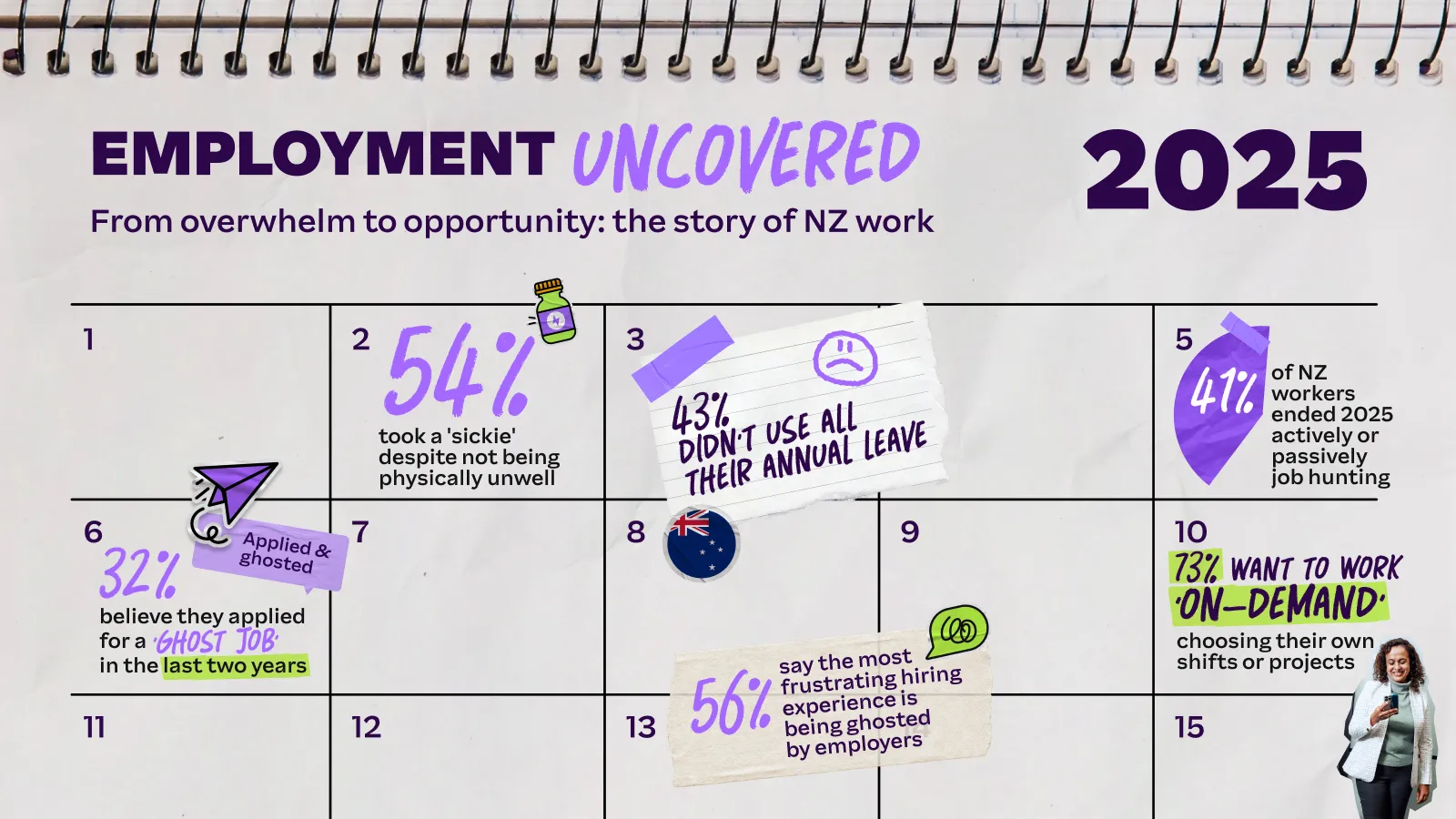 Read more: Employment Uncovered: Inside the Story of New Zealand Work in 2025
Read more: Employment Uncovered: Inside the Story of New Zealand Work in 2025Employment Uncovered: Inside the Story of New Zealand Work in 2025
Inside the story of NZ work in 2025. From rising ‘sickies’ to hiring fatigue, see how Kiwi work patterns are…






















